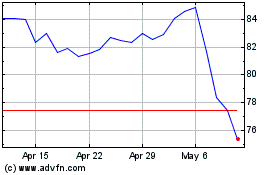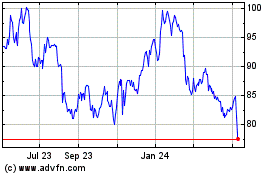Sharp Gears Up for Robot Smartphone Release
April 14 2016 - 1:20AM
Dow Jones News
TOKYO—Sharp Corp. will start shipping its humanoid smartphone,
Robohon, on May 26, the company said Thursday, an ambitious product
that may not be a blockbuster in terms of sales, but could point to
what mobile devices look like in the future.
The robot, which runs on Alphabet Inc.'s Android software,
handles basic functions such as calls, emails, photos and videos.
The bipedal Robohon also communicates with owners through simple
verbal commands and dances. It comes with an embedded projector,
which Sharp developed with Microvision Inc. of the U.S.
Analysts say the 198,000 yen ($1,810) robot won't be a watershed
for cash-strapped Sharp, which earlier this month signed a $3.5
billion takeover deal with Taiwanese iPhone assembler Foxconn
Technology Group.
Yet the robot-smartphone hybrid suggests the "innovative
engineering culture" that Foxconn chief Terry Gou said he loved is
surviving at Sharp, despite the Osaka-based electronics firm's
recent hardships.
"I can't think of any other consumer products that are as
challenging as this, at least in the recent years," said famed
robot creator Tomotaka Takahashi, who collaborated on the Robohon,
at a news conference.
Sharp's financial troubles are rooted in its core display-making
business, because prices for its goods have been falling due to
oversupply in recent years. But its consumer electronics business
is profitable.
Robohon is about 8 inches tall and weighs little less than a
pound.
"I don't think this will be a major hit item," said Hideki
Yasuda, an analyst at Ace Research Institute. "It is too big to
carry around as a smartphone. Some hard-core robot fans would buy
this at the launch, but that would be it."
The product will only be available in retail and online stores,
which will limit sales, analysts said. Many Japanese consumers own
new high-end smartphones, but that is in large part because cash
subsidies from wireless carriers make the handsets virtually free
of charge. Sharp's share of the smartphone market in Japan was just
10% last year, according to research firm Euromonitor.
The size of the market for entertainment robots, which Sony
Corp. created with its Aibo robot dogs in 1999, is small. There
have been many successors, but they are expensive for average
consumers.
Still, Robohon is a positive for Sharp, analysts say, because it
feeds the company's legacy of innovation. The company has had many
successful products, including air purifiers and liquid-crystal
TVs, but it has also rolled out some also-rans.
"In order to make one successful product, you would need nine
failed products first," said Atsushi Osanai, a professor at Waseda
Business School. "The failure is a source of innovation that Sharp
needs to retain no matter who would be managing the company."
The Japanese electronics company was the first to introduce
mobile phones with color displays and was one of the first to put a
camera into the handset.
"Sharp would be able to discover what would come after
smartphones," Mr. Osanai said.
Write to Takashi Mochizuki at takashi.mochizuki@wsj.com
(END) Dow Jones Newswires
April 14, 2016 01:05 ET (05:05 GMT)
Copyright (c) 2016 Dow Jones & Company, Inc.
Sony (NYSE:SONY)
Historical Stock Chart
From Mar 2024 to Apr 2024

Sony (NYSE:SONY)
Historical Stock Chart
From Apr 2023 to Apr 2024
